

 The Accurate Reloading Forums
The Accurate Reloading Forums  THE ACCURATE RELOADING.COM FORUMS
THE ACCURATE RELOADING.COM FORUMS  Guns, Politics, Gunsmithing & Reloading
Guns, Politics, Gunsmithing & Reloading  Reloading
Reloading  In the analysis of a group, what part does imperfections in the bullet
In the analysis of a group, what part does imperfections in the bulletGo  | New  | Find  | Notify  | Tools  | Reply  |  |
One of Us |
In looking at numerous groups the question comes to mind: What part of the cumulative errors does imperfection of the bullet constitute. Meaning, if wind induced errors account for 40%, and loading irregularities another 25%, sighting or operator error some "Y" %; what "X" amount is due to bullet imperfection in the system represented by what we call a group? If all environmetal aspects and other known contributory factors could be eliminated...  Member NRA, SCI- Life #358 28+ years now! DRSS, double owner-shooter since 1983, O/U .30-06 Browning Continental set. | ||
|
| one of us |
What a GREAT question! Beats me, but I look forward to what some of the other guys think. | |||
|
| One of Us |
Questions like that make me want to put a cold rag on my head and lay down for a while. Over in BRC, a fellow wants to know what percentage the various components, ie barrel, stock, ammo, shooter, etc, contribute to the overall accuracy package. Don't forget the randomality of the bullet's fault's placement relative to the true center of the bore would sometimes work in your favor and sometimes against you; compensating on the one hand for aiming errors on your part and on the other hand, exaggerating them. The scientific term for this is: "It'd be a wash." | |||
|
| one of us |
There are three kinds of people; those that make things happen, those that watch things happen and those who don't know what's happening | |||
|
| one of us |
I've mentioned this before, but back in 1909 a fellow named Dr Franklin Mann wrote an entire book detailing his experiments to determine "The Cause Of The Error At Target." He never found the answer. Today, machine rests and tunnels can be used to eliminate virtually all errors except for your "X" factor. It would probably take no more than a million dollars and the rest of your life to narrow it down. Report back when you get there. Ray Arizona Mountains | |||
|
One of Us |
And here I sat chastizing myself for asking a quanatative question which has only qualitative answers... silly me.  Member NRA, SCI- Life #358 28+ years now! DRSS, double owner-shooter since 1983, O/U .30-06 Browning Continental set. | |||
|
| one of us |
| |||
|
| One of Us |
Do you mean bullet inconsistencies like this Swift Scirocco.  When you take a random bullet from a box to be part of a wall display and find this, would you ever use that bullet again. I think not. I dont trust them and Swift isnt interested in it either. Have just got a supplu of GS Custom bullets to try. Now there is a bullet withgout inconsistencies, and a dealer team that spends an enormous amount of time to convey very detailed loading data. Von Gruff. | |||
|
| one of us |
Hey Hivel, I "occasionally" cause something to happen, that as I'm watching it, I wonder what is actually happening!!! If it just stays burried 20 years, it won't matter to me. ----- Hey 308Sako, What answer would you give to your question? | |||
|
| one of us |
HC you are one to get things happening. Me on the other hand, usually wonder what just happened, It helps me crawl out of my little world of random thoughts. Dave | |||
|
| One of Us |
Unless a bullet is made one at a time by elves under a hollow log, imperfections are gonna happen. But then, if they were guarenteed defect free, they would be so expensive, we couldn't afford them. One does wonder what affect out to say 100 or 200 yards that defect would have on the flight of the bullet. I daresay it would have little effect on the upset after impact. I once found a Horady bullet w/o a core. Of course, I knew it the instant I took it out of the box to seat it. Had I been using some sort of progressive press, it might have slipped by. That didn't stop me from buying more Hornady bullets. And that's the only one I've found in @ 45yrs of reloading. | |||
|
One of Us |
What are the odds of landing up with and then ramdomly picking out the only defective bullet made by that company? That type of thing is caused by an attitude at the factoy! (I think). Regards 303Guy | |||
|
One of Us |
Von Gruff, Great picture, but what I am trying to refer to is basically sound bullets with normal tolerance defects, not damaged or out of specification bullets. Regarding Swift, it's not been the same since Lee Reed left there.
Hot Core Well obviousily I have too much time on my hands and not enough neurons to make a single synapse "collapse." But since you asked... I will try to stay in the measurable arena; benchrest shooters can readily achieve groups in the .1"s, so if a shooter was using say a sporter configured to shoot a PPC type cartridge he might then expect "near perfect" performance ALA Dr Mann's quest. Additionally, I am sure we are all familiar with the famed Houston warehouse experiments chronicalled in Precision Shooting magazine years ago. Still better results indoors with extreme efforts to perfection. Now what got me to thinking about this was not unfortunately the typical benchrest style bullet, but rather the 77 grain Sierra MatchKing specifically. So I called Sierra and they could only say that their products would have to meet a certain criteria of 1 1/4" at 200 meters... Not bad but myself and others routinely shoot them more accurately than that. Since I am no Dr Mann best I can do is take a WAG and say the effect is more than zero and less than every other damn thing which causes me to miss! Do hope that helps.  Member NRA, SCI- Life #358 28+ years now! DRSS, double owner-shooter since 1983, O/U .30-06 Browning Continental set. | |||
|
| one of us |
308 OK. I'm guilty of a snarky answer to your post, but did you really expect that anyone had an answer? Ray Arizona Mountains | |||
|
| one of us |
Sako, I've often contemplated much the same... I'm not being silly here, but if you could help me find someone to fund the research, I'd happily pursue the topic.. I have a background in highly complex research with many variables (cognitive neuroscience). High level statistical analysis and mathematical modelling is part of my 'trade'... if I can't do the detailed bits, I know the people who can fill in the gaps. It'd be fun, and a great challenge. Cheers, Pete ******************************** A gun is a tool. A moron is a moron. A moron with a hammer who busts something is still just a moron, it's not a hammer problem. Daniel77 | |||
|
| one of us |
Not much in my experience but as with everything... it depends... If you are shooting non-gaschecked cast bullets and you have imperfections at the heel, they are not going to be particularly accurate. On the other hand when I shot IHMSA production pistol, I used to shoot factory seconds because I could get them cheap and the accuracy difference was insignificant on a pistol with iron sights ( I typically held 2MOA groups). With the revolver, I shot cast, pure wheel weight, gaschecked 180gr 357 bullets and could hold <3moa. And BTW, my casting was by no means perfect. If you shoot BR, you may want to examine/weigh every bullet. For hunting, I wouldn't bother. Just my experience, yours may vary. Have gun- Will travel The value of a trophy is computed directly in terms of personal investment in its acquisition. Robert Ruark | |||
|
| One of Us |
Why not a snarky answer? While the question sounds kewl it really doesn't have a answer since the variables themselves are varying so that a constant can't be determined. Only a +/- spread. | |||
|
One of Us |
Ray, no offense taken at all. It is a bitch of a question... I don't think there is a simple answer what so ever. It might be fair to say that accepting the extremely good accuracy which bullet generally provide and spending effort, time and money elsewhere will be more productive. That is progress! More than anything it is the unseen aspects of the environmental conditions which apparently bite us in the balls when trying to shoot itty bitty groups. I appreciate any and all inputs, thank you gentlemen.  Member NRA, SCI- Life #358 28+ years now! DRSS, double owner-shooter since 1983, O/U .30-06 Browning Continental set. | |||
|
| One of Us |
To start with you would have to define a set of different bullet defects and quantify them. Then you take a set of defective bullets and shoot them in comparison to a set of bullets from a lot known to be free from defects. If you shoot enough you will eventually get some statistics that predict what each defect causes. You might look up the term "design of experiments". | |||
|
| One of Us |
Rail guns aren't that god-awful expensive, I'm sure you could invest in one Sako. There is a reason short range benchrest people use custom bullets lots of the time I bet. Love shooting precision and long range. Big bores too! Recent college grad, started a company called MK Machining where I'm developing a bullpup rifle chassis system.  | |||
|
| one of us |
Hey 308Sako, I do like the questions which cause all of us to think. Your answer is as good as any, and better than my first one. I've leaned toward calling some "Group Stretchers"(not Fliers) regular old Random Group Dispersion. If a person shoots enough Targets, keeps accurate records, and charts the results over time, the old Bell Shaped Curve inevitably appears. Or at least it does for me. When the Dispersion is a bit too "wide" for my taste, I generally go looking for a different Powder. Then if a couple of different Powders don't cure the issue, I eventually and often reluctantly change Bullets. I believe Sierra and Nosler make some of the most consistent and lowest variation Bullets that I've used. Always liked Hornady and never really gave their Match Grade Bullets a fair Test. Used a few boxes while the Sierras were being replaced, but that is not fair to Hornady. ----- So, for what it is worth, after thinking on it a bit, I believe the phenomenon can be reduced by selecting "well made" Bullets. And it is fairly easy for me to pick the ones I believe are a bit better(accuracy wise overall) than the others. But as you mentioned, there will always be something to open the Group a bit. | |||
|
| One of Us |
Assuming you have a match grade rifle and that means a match quality barrel and perfect bedding that has proven historically to deliver tiny little groups: Then if you pick up a different bullet and the groups open to 3" or so, you can bet that the bulk of inaccuracy was in the bullet (assuming you are within the stability requirements of the rifling of the barrel). By bulk I mean greater than 75 % of the error. While it's entirely possible that very bullet may shoot great in someone else's gun, it's not likely. This is why there are so many great reports from people shooting certain bullets such as ballistic tips and interlocks as these bullets are very well made. (and yes others are too) I think the evidence from military tests are that the bullet is the chief component attributing to great accuracy! | |||
|
One of Us |
Hot Core, Well done. Tyler, I will leave a rail in the will for you. SR4759, Yes that would be a scientific approach. rolltop, appreciate the input and concur.  Member NRA, SCI- Life #358 28+ years now! DRSS, double owner-shooter since 1983, O/U .30-06 Browning Continental set. | |||
|
| One of Us |
Wouldn't the "percentage" be the same? Just the bell curve be larger? Ergo you could use a Western Auto rifle as long as everything else was constant except the bullet. The problem, and I don't see how that could be addressed, would be getting the "everything else" constant. that's what bench rest shooters angst over and they have yet to shoot a .0. | |||
|
| one of us |
I'm surprised no one has brought up the Juenke Machine. It's a machine that somehow tests bullets for consistancy. Some people think it's balogna voodoo but there are plenty of successful benchresters who run all their bullets over it and toss out ones that don't score well. I think I remember an article in Handloader years ago that said about 5% of bullets in a box might very well score poorly on the machine. NOW.....is the slight difference in jackets or concentricity going to throw a bullet 2" out on a 100 yd target.....most likely not. And most of us would probably never notice a bullet that isn't perfectly in build. But to think any manufacturer can make 100% perfect bullets every day, 365 days a year is probably not realistic either. I do know that Berger and swift do have one of these machines and check their production from time to time....what they consider acceptable tolerances....I don't know. | |||
|
| One of Us |
Good posting! I would like to see the results of any testing of all makes of bullets to see which come out best on the Juenke Machine. Two days ago, I was out with a 222 Rem Mag sooting Berger 50 grain Varmint bullets and shot the best group from a sporter ever. I was thinking after seeing the group about Berger consistency with their bullets. The group was a 3 shot group at 100 yards with a 20x scope that measured .147", far and away better than any group shot that day, 13 of them. | |||
|
| One of Us |
"three" shot group??? It's the day in and day out that's the problem. I once bought 1000 bulk 55gr Hornady bullets to load for Pdog shooting. They even had a channalure. They were as accurate as any bullet I have shot!! Sierra match, custom made, etc. I was shooting them in a match grade rifle and couldn't believe the groups I was getting. I really thought I was onto something until I bought the second thousand. The 2nd thousand were just ordinary Hornady bulk bullets. Different machine, different day, who knows. | |||
|
| One of Us |
I had a similar experience with Speer TNT's. The first lot I bought shot exceptionally well. The second batch I bought shot terrible. Speer changed the bullets I think as they now have a new black/butterscotch box. The yellow box is long gone. Don | |||
|
| One of Us |
Bullets are very important. Good bullets will shoot much better than bad bullets. I conducted load development with IMR 3031 and AA2520 with 150 grain bullets in an exceptionally accurate Ruger M77. I am going to paste some of the targets. As you can see, military ball ammo is just awful (but the LC 87 was interesting) IMI military 147 FMJ's are just awful. Regardless of charge. I posted the best of the 150 Hornady FMJBT's, and those best groups are just exceptional considering these bullets are not match bullets. Australian Ball 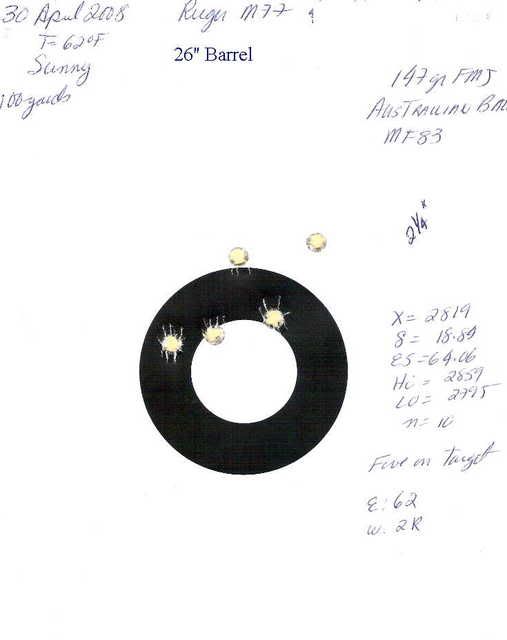 LC 87 Ball 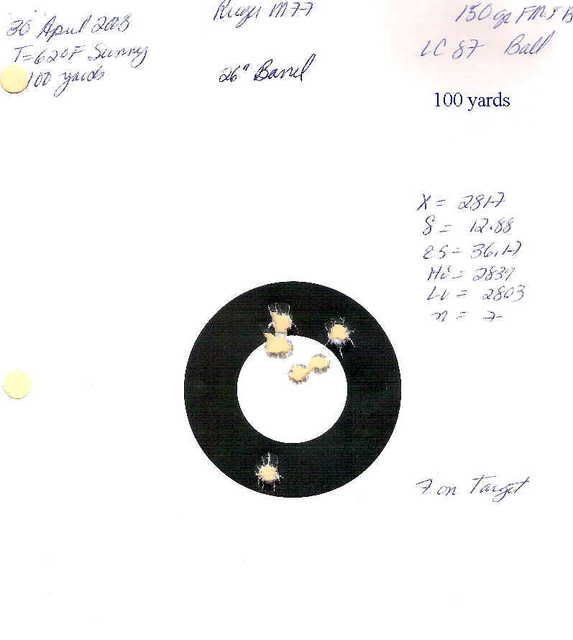 150 gr 1968 WRA 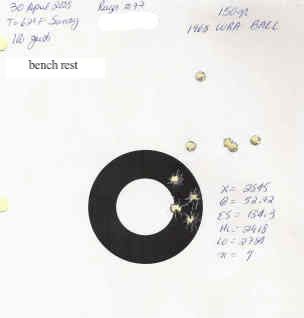 IMI 147 FMJ Bullets  150 Hornaday FMJBT and IMR 3031 (best group) 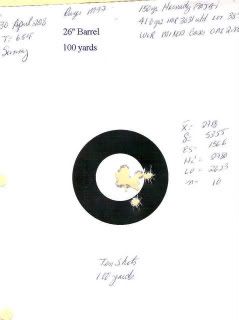 150 Hornaday FMJBT and AA2520, (best group) 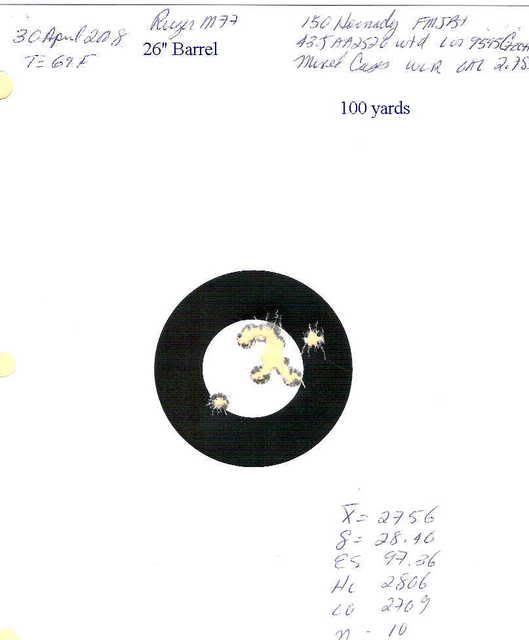 | |||
|
| One of Us |
I think if we restrict ourselves to hunting weight/construction rifles and shoot in a tunnel to eliminate wind, history (and many respected experimenters i.e, Mann, Hagel, Simpson) shows the bullet accounts for about 90% of potential accuracy. As you add other external factors, not ammo (all controllable by the shooter), that percentage is adulterated. | |||
|
| Powered by Social Strata |
| Please Wait. Your request is being processed... |
|
 The Accurate Reloading Forums
The Accurate Reloading Forums  THE ACCURATE RELOADING.COM FORUMS
THE ACCURATE RELOADING.COM FORUMS  Guns, Politics, Gunsmithing & Reloading
Guns, Politics, Gunsmithing & Reloading  Reloading
Reloading  In the analysis of a group, what part does imperfections in the bullet
In the analysis of a group, what part does imperfections in the bullet

Visit our on-line store for AR Memorabilia

